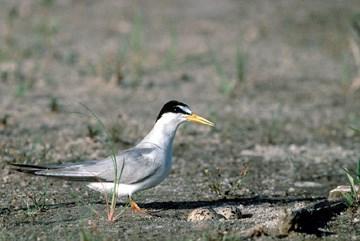
USFWS The interior least tern was listed as a federally endangered species in 1985, due to the loss of nesting habitat from dramatic alterations (channelization and impoundment) of important river systems. It nests on barren sandbars and beaches comprised of sand, shells or salt-encrusted soils and at sand and gravel pits adjacent to the river. The birds may also nest on flat rooftops, possibly in response to the loss of natural habitats. Least terns' nesting success depends on the presence of bare or nearly barren sandbars, favorable water levels during nesting and abundant food. Least terns feed on small fish and crustaceans captured by hovering and diving into shallow water. They defend their nests vigorously, calling and diving at intruders. Water level fluctuations, vegetation of nesting habitat and disturbance (from people, pets, predators and livestock) continue to jeopardize nesting success. |
Last updated: April 10, 2015
